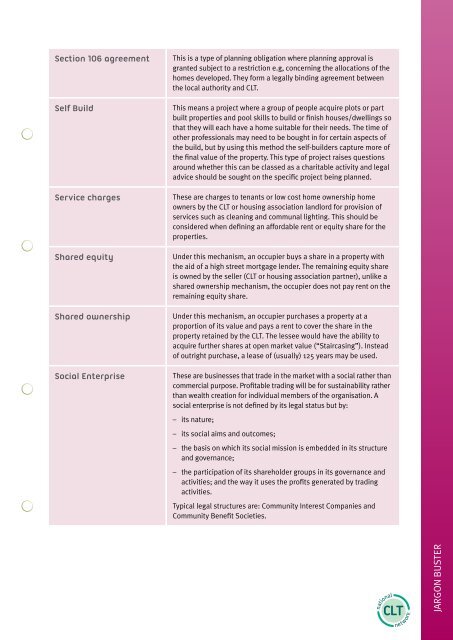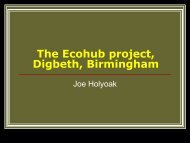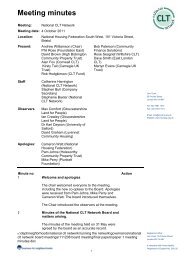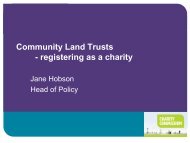CLT Jargon Buster (pdf) - Community Land Trusts
CLT Jargon Buster (pdf) - Community Land Trusts
CLT Jargon Buster (pdf) - Community Land Trusts
Create successful ePaper yourself
Turn your PDF publications into a flip-book with our unique Google optimized e-Paper software.
Section 106 agreementSelf BuildService chargesShared equityShared ownershipSocial EnterpriseThis is a type of planning obligation where planning approval isgranted subject to a restriction e.g, concerning the allocations of thehomes developed. They form a legally binding agreement betweenthe local authority and <strong>CLT</strong>.This means a project where a group of people acquire plots or partbuilt properties and pool skills to build or finish houses/dwellings sothat they will each have a home suitable for their needs. The time ofother professionals may need to be bought in for certain aspects ofthe build, but by using this method the self-builders capture more ofthe final value of the property. This type of project raises questionsaround whether this can be classed as a charitable activity and legaladvice should be sought on the specific project being planned.These are charges to tenants or low cost home ownership homeowners by the <strong>CLT</strong> or housing association landlord for provision ofservices such as cleaning and communal lighting. This should beconsidered when defining an affordable rent or equity share for theproperties.Under this mechanism, an occupier buys a share in a property withthe aid of a high street mortgage lender. The remaining equity shareis owned by the seller (<strong>CLT</strong> or housing association partner), unlike ashared ownership mechanism, the occupier does not pay rent on theremaining equity share.Under this mechanism, an occupier purchases a property at aproportion of its value and pays a rent to cover the share in theproperty retained by the <strong>CLT</strong>. The lessee would have the ability toacquire further shares at open market value (“Staircasing”). Insteadof outright purchase, a lease of (usually) 125 years may be used.These are businesses that trade in the market with a social rather thancommercial purpose. Profitable trading will be for sustainability ratherthan wealth creation for individual members of the organisation. Asocial enterprise is not defined by its legal status but by:– its nature;– its social aims and outcomes;– the basis on which its social mission is embedded in its structureand governance;– the participation of its shareholder groups in its governance andactivities; and the way it uses the profits generated by tradingactivities.Typical legal structures are: <strong>Community</strong> Interest Companies and<strong>Community</strong> Benefit Societies.JARGON BUSTER






